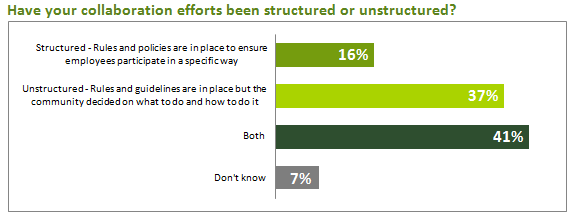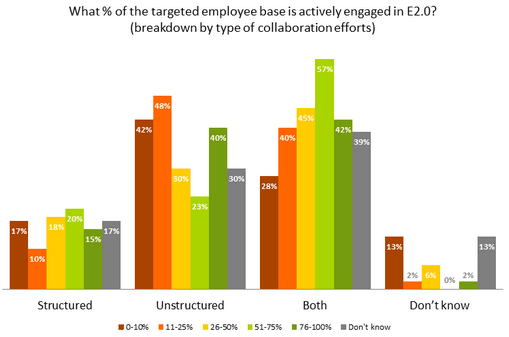There are effectively two approaches to collaboration in the enterprise; structured and unstructured. But which approach should organizations go with and which is more effective? The structured approach involves more rules, guidelines, and restrictions. For example one pharmaceutical company executive I spoke with told me that his employees are not allowed to mention the names of the products that the company produces in their internal environment. Other examples might include strict naming conventions for groups or files, specifications on types of content that can be shared, or perhaps restrictions on types of groups or discussions that can be had (for example everything must be work related). An unstructured approach usually has some guidelines and best practices but relatively leaves the employees unregulated in terms of how they can collaborate and use internal tools and platforms. Clearly for some companies such as banks, pharmaceutical companies, and other regulated industries; some form of a structured approach is going to be mandatory (at least for now).
Based on data that Chess Media Group collected from our “State of Enterprise 2.0 Collaboration Report” which surveyed 234 practitioners from around the world, we can see that the majority of organizations actually go with a combination of a structured and an unstructured approach, the second most popular choice is an unstructured approach. However, the structured approach is the method least utilized by organizations.

But this still doesn’t answer the question of which approach is most effective. In order to see that, we cross referenced the types of approaches with the percentage of the targeted employee base that is actively engaged.

In the above chart we can see that the 51-75% and 76-100% engagement levels are highest in the “both” approach (as is the 26-50%). Meaning that when the organization deploys a combined method, a higher percentage of the targeted employee base is actively engaged. These levels are followed by the “unstructured” approach and again the “structured” approach yields the lowest levels of engagement. So based on this data a combination of some rules and regulations that still gives employees collaborative freedom is the best approach. Too much freedom or not enough freedom does not yield the same levels of engagement as a combination of both.
Now keep in mind that this doesn’t mean your organization has to take one approach or the other this simply shows findings from our report.
What does an organization do with this information? For starters consider the data that the “both” approach seems to be the most effective and begin evaluating what types of specific rules should be put in place and what types of freedoms should employees have? P&G for example learned that right from the get-go they should have been more stringent with their naming conventions and tagging for internal files and content because now it appears as though there is duplicate information floating around their internal platform. Naming conventions might want to be one place where your organization enforces a structured approach.
At this stage a simple discussion with your collaboration team around these approaches should yield some interesting conclusions, just ask yourselves, “where should employees follow specific rules and where can we let them have full freedom?”
Comments